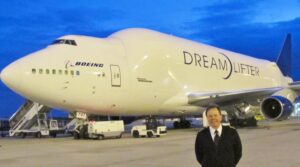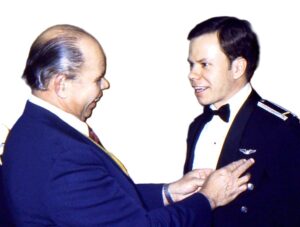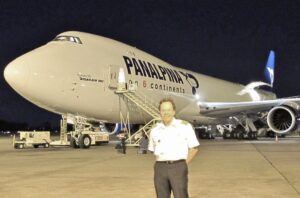In honor of Military Month, we are profiling employees who have either served or are currently serving in the military. This week, we meet Air Force Veteran and Retired Atlas Captain Todd Peckman. Todd has been part of the Atlas family for decades, first as a pilot for 19 years and now as an Atlas 747 Flight Instructor and Tech Panel Lead. As a 747 Flight Instructor, he trains pilots in the Sim in the Miami Training Center and as Tech Panel Lead, he helps the HR department develop technical interview questions for prospective pilots.

Captain Peckman with the Dreamlifter.
What inspired you to get involved in aviation?
Growing up, I was always building military airplane models, taking after my lifelong role model – my father. He had a highly successful career as a United Stated Air Force (USAF) pilot and flew a lot of what we consider “warbirds” today: the T-6, B-25, C-54, C-119, DC-6 and later, the C-130. Over the course of his career, he was hand-picked for some highly complicated missions, including one that was assigned directly by President John F. Kennedy. In October 1962, he received a call from Kennedy’s office asking him to fly a sensitive and dangerous C-130 mission during the Cuban Missile Crisis.
When did you know you wanted to be a pilot?
In 1974, when the energy crisis and associated recession hit, I was well on my way to becoming a professional college student at the University of Pittsburgh, but money was becoming scarce. My dad pointed out that the Air Force Reserve Officer Training Program was paying $100 per month, so I signed up. Despite massive military cutbacks in 1975 and 1976, due to the Vietnam drawdown, three fellow college classmates and I were awarded pilot slots.
I was surprised and had some doubts – would I succeed? But I decided to try. When I finally arrived at USAF Undergraduate Pilot Training (UPT) in 1978, I started to get an idea of the incredible opportunity I had received, but I was still undecided about a career as a pilot. UPT was difficult but failure was not an option, so I hammered through with the goal of a C-130 assignment because my dad had enjoyed flying it.
I successfully completed UPT and found myself in the C-130 training school, learning low-altitude flying, short-field landings, airdrop of equipment and paratroopers and formation flying at high and low altitudes. But even then, to me, flying was just another job; it wasn’t fulfilling.
After C-130 school, my first assignment was to Elmendorf Air Force Base near Anchorage, and that’s where I really learned to fly. We flew to mountaintop sites in the middle of the Alaskan winter and landed on isolated, icy dirt and gravel runways. We had to fly in food and equipment every 4-5 days to resupply the personnel at those sites. It was then, experiencing the challenges and seeing the importance of those missions that I realized I loved flying and it’s what I wanted to do for the rest of my life.
What is your most memorable moment since becoming a pilot?

(L-R) Captain Peckman’s father pinning on his wings after graduation from Air Force Pilot Training.
There are many moments. I feel extremely blessed in aviation. First was the moment my dad, the retired Colonel, pinned my USAF Pilot Wings on my uniform at graduation from Air Force Pilot Training. His tears said it all.
There was also the time when I was selected with three other C-130 pilots from my squadron in West Germany to fly then-Vice President George H. W. Bush into remote hunger camps in Sudan. My call sign was, “Air Force Two!”
Much later, I was selected to the C-17 Initial Cadre at Charleston, SC. The C-17 was new then, and my memorable times in it included flying the brand-new C-17’s out of the McDonnell Douglas Factory where they were manufactured.
Another key memory was when I was teaching at the first C-17 Formal School. I trained new C-17 pilots at Altus Air Force Base in Oklahoma and commanded that unit, the 58th Airlift Squadron, as we grew to 8 C-17’s and 260 personnel. What a blessing to be a part of that history!
How did you find Atlas?
After I retired from the USAF in 1997, I sought out Atlas for my next flying career. Many of my retired military friends preceded me here. They reported so many good things about flying with Atlas. I loved fleet of brand-new 747-400 jets and the high quality and quantity of international flying.
One of my favorite Atlas memories was my first flight on the line while training with Line Check Captain Ollie Weller. We took off in a snowstorm from Newark, New Jersey to land on a spring-like day in Paris, France. He was the quintessential international 747 Captain: tall, dapper, his full head of hair combed straight back with that touch of grey at the temples. I thought he was a Sky God!
In the years after, the 747 Fleet Captains I worked for were very supportive. I’ll always be grateful for the opportunities they gave me!
What is the most interesting cargo you have ever flown?
In 1994, while flying the C-17, I once landed at an airstrip in the Tonopah Test Range in Nevada as part of a congressionally mandated test of the aircraft. We immediately loaded, with our engines still running, a combat-ready, 60-ton M1 Abrams Battle Tank into the hold. Only 21 minutes after landing, we lifted off with the tank and 20 Army Troops on board. I had nine minutes of legal fuel remaining to spiral up to a KC-135 tanker, which was spiraling down to me, so we could link up and air-refuel with enough fuel to fly back to the East Coast. The C-17 is so incredible, it all went without a hitch.
At Atlas, it amazes me the variety of cargo we haul. I’ve flown fresh salmon from Santiago, car parts to Guadalajara, and fresh flowers from Bogota. The variety of cargo and destinations is mind-boggling! But, to me, the best “cargo” I ever flew was people, the men and women of the armed services and their families. What a privilege!
What was your favorite part about being an Atlas pilot?

Captain Peckman after his first flight on the 747-8 as part of the 747-8 Initial Cadre.
Traveling internationally to so many major cities was definitely a nice perk, but my favorite part about being an Atlas pilot has been the opportunity to train other pilots. I love it when a student has “The Aha!” moment. From developing 747-8 curriculum early on, to teaching new hires on the line and in simulators, Atlas helped me realize that teaching is my true passion.
Another memorable moment was being selected to the 747-8 Initial Cadre. I remember my first flight in a 747-8 like it was yesterday. It was the second flight of the Federal Aviation Administration’s Proving Runs for the aircraft certification at Atlas. We flew from Luxembourg to Huntsville, Alabama.
Finally, I relish the memory of being Atlas Initial Cadre on the Boeing Large Cargo Freighter, or LCF. The first time I walked up to that jet, I wondered how a monster like that could fly. Well of course, it flies beautifully — even though it looks like a propane tank with wings!
What made you want to stay with Atlas after retirement?
I was so grateful that the Flight Ops Team invited me to stay and continue teaching simulator sessions after retirement. My favorite part of my job is teaching in the Sim. Following my retirement, the Atlas Human Resources Team reached out to me through one of our Chief Pilots and allowed me to join their pilot hiring process as a technical interviewer. I am so proud of that association, especially being involved in the behind-the-scenes HR and Flight Ops interface, successfully hiring new pilots. My contribution to that process, developing fair and appropriately targeted flight-related technical question banks for pilot candidate interviews, has also been very satisfying.

Captain Peckman’s model trainsets on display.
What is something your coworkers would be surprised to know about you?
I think they would be surprised at one of the many ways I celebrate Christmas. I set up five HO scale (HO is a rail transport modelling scale using a 1:87 scale) electric train sets on the floor around our Christmas tree every year. Complete with towns, roads, vintage cars, mountains and even a complete small-town airport with HO scale airplanes. Three of the five sets are models of trains I have traveled on with my family: The Alaskan Railroad, complete with Vista-View cars, The Durango-Silverton Express (Colorado, the train of 1960’s “Butch Cassidy & Sundance Kid” fame) and the Atlanta Zoo People Mover.